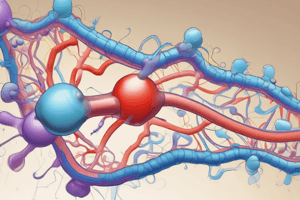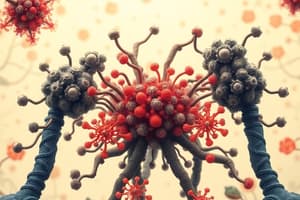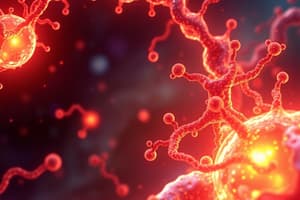Podcast
Questions and Answers
What occurs when an extracellular signal molecule binds to a GPCR?
What occurs when an extracellular signal molecule binds to a GPCR?
- The G-protein remains inactive with GDP bound.
- The receptor undergoes a conformational change activating the G-protein. (correct)
- The G-protein binds directly to the ion channels in the membrane.
- The G-protein immediately hydrolyzes GTP to GDP.
Which component of the G-protein is involved in the exchange of GDP for GTP?
Which component of the G-protein is involved in the exchange of GDP for GTP?
- Alpha subunit (correct)
- G-protein-coupling receptor
- Beta subunit
- Gamma subunit
How does RGS regulate G-protein signaling?
How does RGS regulate G-protein signaling?
- By stabilizing the G-protein in its active form.
- By activating the GTPase activity of the alpha subunit. (correct)
- By acting as a guanine nucleotide exchange factor.
- By increasing the exchange rate of GDP for GTP.
What is the significance of GTP hydrolysis in the function of G-proteins?
What is the significance of GTP hydrolysis in the function of G-proteins?
What characteristic of GPCRs allows them to activate different types of G-proteins?
What characteristic of GPCRs allows them to activate different types of G-proteins?
Flashcards are hidden until you start studying
Study Notes
G-protein Coupled Receptor (GPCR)
- GPCRs are membrane-bound proteins that bind to signaling molecules, initiating a cascade of events within the cell.
- The binding of an extracellular signaling molecule causes a conformational change in the GPCR, allowing it to activate a GTP-binding protein (G-protein).
- These receptors thread through the cell membrane seven times, with the N-terminus located outside the cell and the C-terminus inside the cell.
G-Protein Structure and Activation
- G-proteins are heterotrimeric, meaning they consist of three subunits: alpha, beta, and gamma.
- In their inactive state, G-proteins have GDP bound to the alpha subunit.
- Upon signal molecule binding to the GPCR, the alpha subunit's affinity for GDP decreases, allowing GTP to bind in its place.
- This binding event causes the alpha subunit to detach from the beta and gamma subunits, activating the G-protein.
- Activated alpha and beta/gamma subunits interact with target proteins, such as enzymes or ion channels, to trigger cellular responses.
G-Protein Deactivation and Regulation
- The alpha subunit possesses GTPase activity, meaning it can hydrolyze GTP back to GDP.
- This GTP hydrolysis returns the alpha subunit to its inactive conformation, allowing it to reassociate with the beta/gamma subunits.
- GTPase activity is enhanced by the binding of the alpha subunit to target proteins or RGS proteins.
- RGS proteins are specific regulators of G-protein signaling and act as GTPase activating proteins (GAPs), accelerating the GTP hydrolysis process.
- This rapid deactivation of G-proteins ensures a precise and controlled cellular response.
Studying That Suits You
Use AI to generate personalized quizzes and flashcards to suit your learning preferences.




